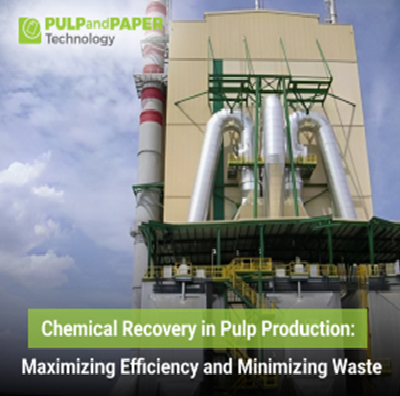Chemical Recovery in Pulp Production: Maximizing Efficiency and Minimizing Waste

Pulp production is a vital industry that provides the raw material for paper and various other products we use in our daily lives. However, it's also a resource-intensive process that generates significant waste and environmental challenges. To address these issues, the concept of chemical recovery has emerged as a key strategy to maximize efficiency and minimize waste in pulp production.
The Basics of Pulp Production
Before diving into the details of chemical recovery, let's first understand the basics of pulp production. Pulp is typically made from wood fibers, which are extracted from various types of trees, including softwood and hardwood. The process begins with the harvesting of trees and then proceeds through several stages, including chipping, pulping, and papermaking.
One of the primary challenges in pulp production is separating the wood fibers from lignin, a natural polymer that gives strength to the wood. This separation process is achieved through chemical pulping methods, primarily the kraft process. However, these chemical pulping methods generate a considerable amount of waste, including spent cooking liquor and black liquor, which contains lignin and various chemicals.
The Challenge of Waste in Pulp Production
Waste management is a significant concern in the pulp production industry. Historically, much of the waste generated during chemical pulping was disposed of in ways that harmed the environment. For example, black liquor was often dumped into rivers or incinerated, releasing pollutants into the air.
This unsustainable approach had severe environmental consequences, including water pollution, deforestation, and air pollution. As public awareness of environmental issues grew, so did the pressure on the pulp industry to find more sustainable solutions.
| Also Read: Advancements in Pulping Processes: Chemical, Mechanical, and Hybrid Methods |
The Role of Chemical Recovery
Chemical recovery is the answer to the environmental challenges posed by pulp production. It's a set of processes and technologies designed to extract valuable chemicals from the waste streams generated during pulping. By recovering and reusing these chemicals, pulp mills can achieve several important goals:
1. Maximizing Efficiency
Chemical recovery allows pulp mills to make the most of their resources. By recycling and reusing chemicals, mills can reduce the need to purchase expensive new chemicals, thereby cutting production costs.
2. Minimizing Waste
Chemical recovery significantly reduces the amount of waste generated by pulp mills. Instead of discarding valuable chemicals, they are reclaimed and reused in the pulping process. This not only reduces environmental impact but also lowers disposal costs.
3. Reducing Environmental Impact
One of the most substantial advantages of chemical recovery is its substantial positive contribution to the environment. By averting the discharge of hazardous substances into water bodies and the atmosphere, the pulp industry can significantly diminish its environmental impact.
The Chemical Recovery Process
Chemical recovery involves several key steps to extract valuable chemicals from waste streams. Here's an overview of the process:
1. Black Liquor Evaporation
Black liquor, the waste byproduct from the kraft pulping process, contains lignin and various chemicals. In the chemical recovery process, black liquor is first collected and then subjected to evaporation. This step removes water from the black liquor, leaving behind a concentrated mixture.
| Also Read: Efficiency and Sustainability: Innovations in Chemical Recovery for Papermaking |
2. Chemical Recovery Furnace
The concentrated black liquor is then burned in a chemical recovery furnace, where it undergoes a process called smelting. During smelting, the organic matter in the black liquor is burned, leaving behind a solid substance called "smelt." This smelt contains valuable chemicals, including sodium carbonate and sodium sulfide.
3. Smelt Dissolving Tank
The smelt is dissolved in water in a smelt-dissolving tank, producing a green liquor. This green liquor is a mixture of chemicals that can be used in the pulping process.
4. White Liquor Preparation
The green liquor is then treated to produce white liquor, which is a critical chemical used in the kraft pulping process. White liquor consists mainly of sodium hydroxide and sodium sulfide and is used to break down wood chips into pulp.
5. Lime Mud Generation
Another byproduct of the chemical recovery process is lime mud, which contains calcium carbonate. Lime mud can be used in various applications, including as a soil conditioner or in the production of cement.
The Benefits of Chemical Recovery
Chemical recovery is a win-win for both pulp mills and the environment. Here are some of the key benefits:
1. Economic Savings
By reusing chemicals and reducing waste, pulp mills can significantly cut production costs, making them more competitive in the market.
2. Environmental Protection
Chemical recovery reduces the environmental impact of pulp production by preventing pollution of waterways and air. This helps protect aquatic ecosystems and reduces the carbon footprint of the industry.
3. Resource Conservation
Chemical recovery conserves valuable resources by extracting and reusing chemicals from waste streams. This reduces the need for harvesting additional trees and mining for raw materials.
Ongoing Research and Innovations
The pulp industry is not stagnant; it continues to evolve and improve its environmental performance through ongoing research and innovations in chemical recovery. Researchers and engineers are constantly working to develop more efficient chemical recovery processes and technologies. This includes advancements in evaporation techniques, smelting technology, and the optimization of chemical recovery furnaces to increase energy efficiency and reduce emissions.
Furthermore, the industry is exploring ways to expand the use of recovered chemicals beyond the pulp mill. For example, some mills are selling excess recovered sodium carbonate to other industries, creating additional revenue streams while reducing waste further.
Adherence to Regulations and Sustainability Objectives
Chemical recovery additionally aids pulp mills in aligning with stringent environmental regulations and sustainability objectives. Numerous nations have instituted rigorous guidelines concerning the discharge of industrial wastewater and emissions into the air. Through the adoption of efficient chemical recovery systems, pulp mills can fulfill these regulatory requirements while showcasing their dedication to sustainable principles.
Moreover, as global awareness of climate change and environmental preservation grows, customers and investors are increasingly looking for businesses that prioritize sustainability. Pulp mills that embrace chemical recovery can market their products as more environmentally friendly, enhancing their reputation and marketability.
Conclusion:
In the realm of pulp production, chemical recovery stands out as a pivotal transformation. It not only offers economic benefits through cost reduction and enhanced efficiency but also harmonizes with the escalating societal and environmental emphasis on sustainability. As the pulp industry persists in adapting and pioneering, chemical recovery will endure as a core approach for optimizing efficiency, curbing waste, and securing a more environmentally conscious path for the future of pulp production. Embracing these practices empowers the industry to strike a harmonious balance between economic prosperity and environmental guardianship, thus assuring a brighter, more sustainable future for generations to come.









